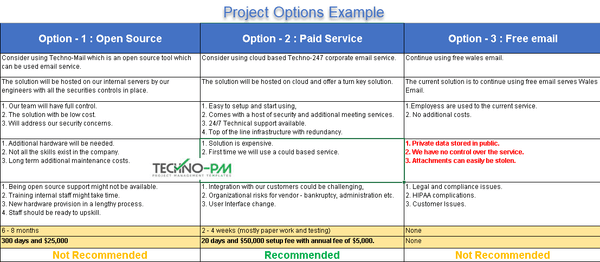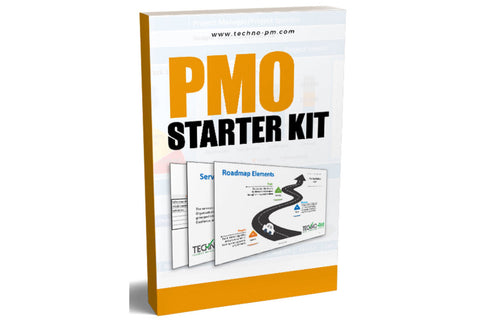7 Simple Steps to Write Options Paper Template
Options Paper Template
At some point in your professional life, you will be asked to provide options for certain tasks or events to your senior management. To be able to get give all the information you need to ensure you first collect all the information required. This options paper template and steps will enable you to provide all the information required to your management for decision making.

Step 1: Understand the matter at hand
- If you are reading this, it means you will present an options paper to someone important.
- You should first try to understand what is the problem at hand. Look for email trails, incident reports, status reports, or talk to affected users.
- In case of a new system, talk to the sponsor or systems users who will know more about the issue.
- This might be a time-consuming process, but you must be 100% confident about the issue as you might be asked questions anytime.
Step 2: Research to know your options
- The first thing to do is detailed research about the options. It is a good idea to discuss with your colleagues or managers who know about the problem at hand.
- Dig through procedures and documents to find out any options.
- Check with your experienced colleagues to find how these things were handled in the past.
- Discuss with SMEs to find out options.
Step 3: Outline for options
- For each of the options identified, create an outline of the tasks involved.
- Understand the high-level steps involved to reach the solutions.
- Documenting the outline or approach is very helpful as it may be able to identify assumptions or issues.
Step 4: Perform risk assessment
- Go through an exercise of doing a risk assessment for each of the options you have identified.
- It is important to highlight the risks involved as it will help in making a decision.
- If an option is straightforward to implement but has many risks associated with it, the management needs to know if that option should still be considered.
- Sometimes an option might introduce additional risks to the organization.
- The management should be aware of all the risks involved before making a decision.

Project Options Example
Step 5: Identify Dependencies
- In a large organization, any task or project undertaken will generally have dependencies on other factors.
- The other factors can be human resources, funding, customer impacts, contractual obligation, compliance obligations, etc.
- If dependencies are not considered when selecting or planning an option, it may never be possible to implement it.
- You may start working on the option but then will not progress without having all the resources required.
Step 6: Cost, Effort, and Timeline Estimate
- Cost, effort, and delivery timeline are the most important parameters considered by management when making decisions.
- The cost can be resource costs, software costs, hardware costs, or license costs.
- If the work is being done by your team with no additional costs, then having an effort estimate is good.
- Either way, many decisions tend to be taken based on cost factors as there is always a fixed budget and timeline.
Step 7: Drafting the options
- After you have collected all the information required, you can start drafting the options using the excel template.
- Keep the points brief and crisp so that people don’t get lost in words.
- Remember, the people reading these options and making decisions will be senior and will not have all the time in the world to read and understand each of the lines.
- If there is something significant, you want to highlight that mark that content in RED to catch people's attention.
Getting your options paper approved
- Check the basics spelling, grammar, font size, colors, etc.
- Have realistic options and have maximum information on each option as that will give management the confidence that you have the due diligence required.
- Always have a recommendation. As you would have done all the research and hard work on the subject, you will be aware of the best option.
- It is a good idea to run the draft through someone senior or one of your colleagues.
- It helps gather some support for the option that you want to implement by discussing this paper with people who will support you.
- If you know the sponsor or who is ready to fund it, make sure you align your choices to get what you want.
- If it is a board, then Typically, options papers are sent to senior managers or boards for approval, so doing the required legwork is important for your options' success.
Example of the Project Options Paper
|
Options |
Option - 1: Open Source |
Option - 2: Paid Service |
|
Description |
Consider using Techno-Mail, which is an open-source tool that can be used email service. |
Consider using cloud-based Techno-247 corporate email service. |
|
Option Outline |
The solution will be hosted on our internal servers by our engineers with all the securities control in place. |
The solution will be hosted on the cloud and offer a turnkey solution. |
|
Pros |
1. Our team will have full control. 2. The solution with below cost. 3. Will address our security concerns.
|
1. Easy to set up and start using, 2. Comes with a host of security and additional meeting services. 3. 24/7 Technical support available. 4. Top-of-the-line infrastructure with redundancy. |
|
Cons |
1. Additional hardware will be needed. 2. Not all the skills exist in the company. 3. Long-term additional maintenance costs. |
1. The Solution is expensive. 2. First time, we will use a could-based service. |
|
Risks/Dependencies |
1. Being open-source, support might not be available. 2. Training internal staff might take time. 3. New hardware provision in a lengthy process. 4. Staff should be ready to upskill. |
1. Integration with our customers could be challenging, 2. Organizational risks for vendor - bankruptcy, administration, etc. 3. User Interface change. |
|
Timeline |
6 - 8 months |
2 - 4 weeks (mostly paperwork and testing) |
|
Effort/Cost |
300 days and $25,000 |
20 days and $50,000 setup fee with an annual fee of $5,000. |
|
Recommendation |
Not Recommended |
Recommended |




